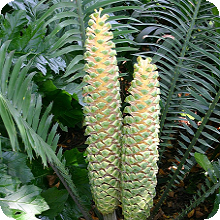|
| Division: Cycadophyta |
| Class: Cycadopsida |
| Order: Cycadales |
| Family: Zamiaceae |
| Genus: Encephalartos |
| Species: E. villosus |
Conservation Status: |

E. villosus
Forest CycadEncephalartos villosus occurs from the East London vicinity, where it is found near the coast, to the northern border of Swaziland where it may grow as far as 100 km inland. As a result of its large geographical distribution, it is notably variable in leaf and cone shape.
It is one of the most common ornamental dwarf cycads in southern Africa. It is shade-loving and produces leaves which spread out gracefully, with glossy dark green leaflets. This species is a fast grower and in 5 to 8 years will develop into a substantial plant.
This species is often found growing in clusters and the stem is usually subterranean. If a stem develops above ground, it may grow to a height of up to 0.4 m and a diameter of 250 mm, with the occasional sucker. The young leaves are densely covered with white hairs. The mature leaves are dark green, glossy and lighter green on the underside of the leaves. The leaves are 1.5 to 3 m long, with the median leaflets ranging from 150 to 250 mm in length. The width of the leaflets are 15 to 20 mm.
This species produces 1 to 4 cones on the female plants. The male cones are lemon-yellow, 600-700 x 120-150 mm, and can bear up to 5 cones. When mature, the male cone exudes an unpleasant odour. The female cone is a deep yellow, 300-500 x 200-250 mm.
The seeds are dark red.
Cultivation:
Encephalartos villosus responds well to cultivation, provided it is grown in light shade, is well drained, with sufficient moisture in frost-free conditions. Ideal companion plants are Veltheimia bracteata, Scadoxus multiflorus subsp. catherinae, Asparagus densiflorus (Gwebe) and the genus Plectranthus.
It is best to grow young seedlings on until the leaves are about a metre high before planting in the open ground. Dig a hole half a metre square and deep. Half fill the hole with well-matured compost, add a cup of bone meal and organic fertilizer. Mix well in the hole and then plant the cycad so that the growing point is just above the level of the ground.
As far as pests are concerned, scale insects could be a problem and need to be treated with an oil based insecticide.
| shade | dark green | low watering | fast growth | frost-sensitive | common |
Encephalartos villosus responds well to cultivation, provided it is grown in light shade, is well drained, with sufficient moisture in frost-free conditions. Ideal companion plants are Veltheimia bracteata, Scadoxus multiflorus subsp. catherinae, Asparagus densiflorus (Gwebe) and the genus Plectranthus.
It is best to grow young seedlings on until the leaves are about a metre high before planting in the open ground. Dig a hole half a metre square and deep. Half fill the hole with well-matured compost, add a cup of bone meal and organic fertilizer. Mix well in the hole and then plant the cycad so that the growing point is just above the level of the ground.
As far as pests are concerned, scale insects could be a problem and need to be treated with an oil based insecticide.
E. villosus for sale at AfricaCycads.com:
